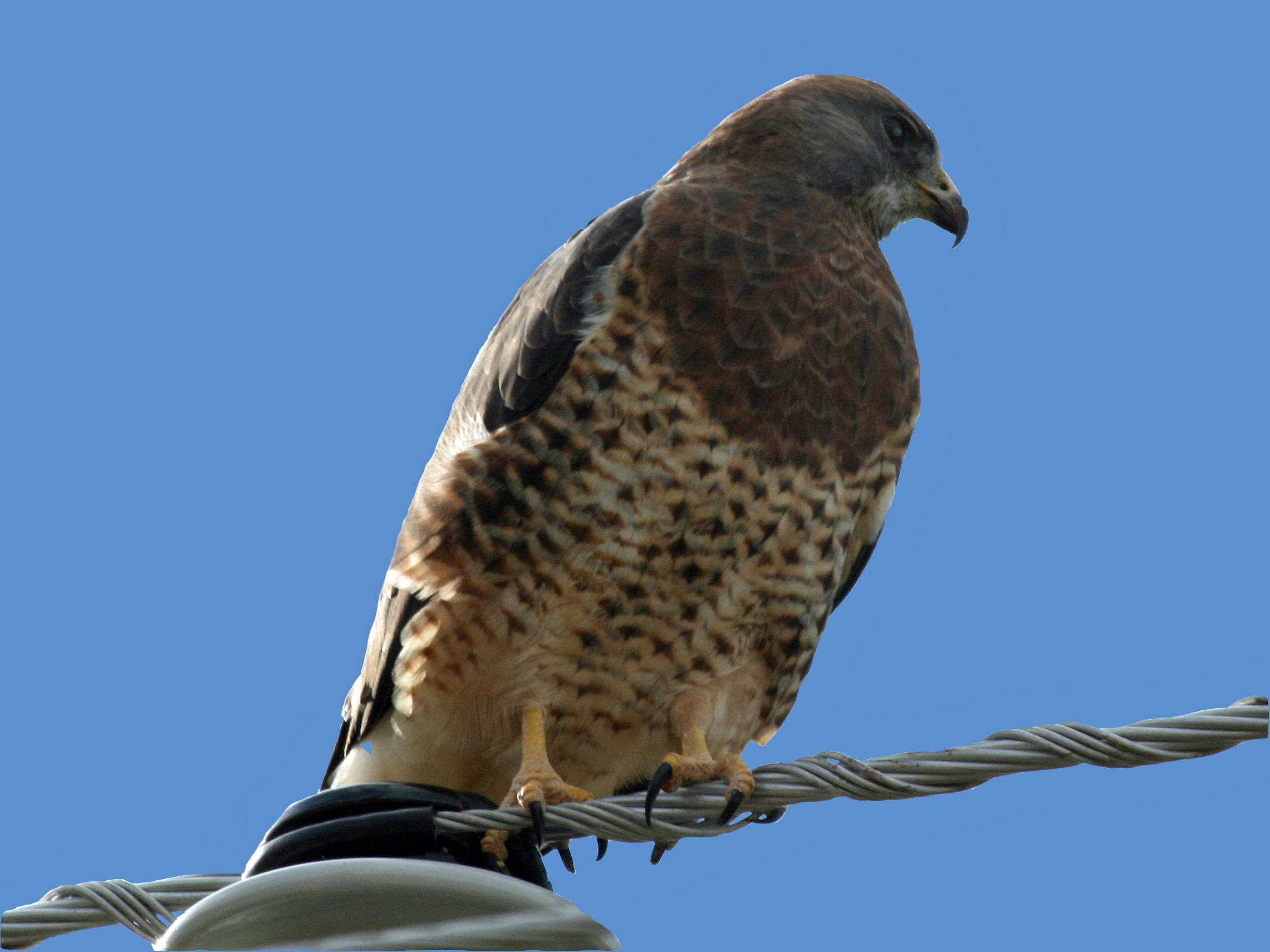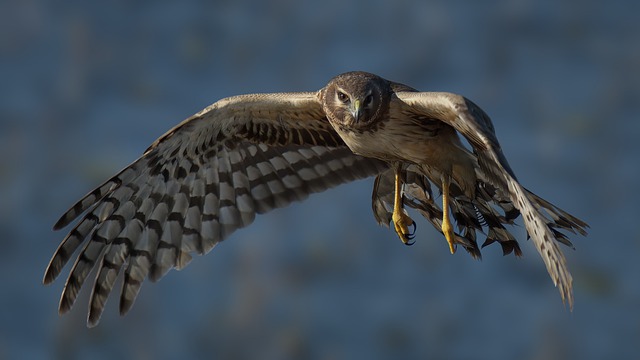Hi there! In this article, I will be introducing you to the eight different types of hawks that can be found in the beautiful state of Oregon.
Hawks are majestic birds of prey that are known for their sharp talons, keen eyesight, and impressive hunting abilities.
Each of these eight hawk species has its unique characteristics, behaviors, and habitats, so let’s dive in and explore these fascinating creatures together.
| Image | Name |
|---|---|
 | Swainson's Hawk |
 | Rough-legged Hawk |
 | Ferruginous Hawk |
 | Cooper’s Hawk |
 | Red-Tailed Hawk |
 | Northern Goshawk |
 | Northern Harriers |
 | Sharp-Shinned Hawk |
Types of Hawks in Oregon
1. Swainson’s Hawk

The Swainson’s Hawk is a typical sight in the summer months flying on its thin wings over the vast land of the Great Plains, the Western United States, and even much of Oregon to the north.
Among the longest-distance migrants of any American hawk, they often travel in groups of over 10,000 birds.
While migrating to their Argentine wintering grounds in the autumn, these hawks prefer to fly across wide territory rather than along lake or ridges beaches like many other species.
This hawk will adjust its food to suit its reproductive status.
They follow the standard “buteo” diet of reptiles, rodents, and rabbits while raising young, but when they’re not reproducing, they convert to a diet consisting nearly entirely of insects.
They rush for dragonflies and grasshoppers for protein while they are on the ground.
To achieve maximum speed while pursuing bigger prey, such as rodents, they fly with their wings folded in a narrow V configuration.
2. Rough-legged Hawk

It’s possible to see Rough-legged Hawks everywhere across Oregon outside of their mating season.
The wide Arctic tundra is their year-round home and breeding ground.
The birds spend the wintertime in the southern portion of the US and southern Canada, but every year in the autumn, they make the long journey north to spend the summer in warmer climes.
They migrate to Oregon for the winter, albeit they are more elusive than some other species.
The availability of lemmings, a primary food source, in the Arctic has a significant impact on the population of these animals, which varies widely throughout the year.
Rough-legged Hawks are so-called because the feathers on their lower legs keep them warm in the Arctic.
Just these hawks and the Golden Eagle are the sole predators in the Americas that have plumage on their legs and feet, all down to their talons.
Yet, the Rough-legged Hawk is a huge buteo hawk having a stocky body and long, wide wings.
Compared to other buteos, they have very long tails and unusually tiny beaks and feet.
They spread out their tails and keep their wings in a “V” formation while in flight.
Both light and dark variants are only two of the numerous feather color variations seen across North America.
Mature males of the light variant have white underparts and grayish-brown uppers, whereas those of the dark variant are normally dark brown throughout except for their underwings.
3. Ferruginous Hawk

Only during the mating season may the Ferruginous Hawk be seen in its eastern Oregon habitat.
Yet as you notice on the distribution map, there is a little enclave of these birds that spend the winter around Southern Oregon.
It’s the biggest hawk throughout Oregon and one of the biggest in North America; thus, it hangs out over broad ranges and deserts out West.
The rusty coloration of the Ferruginous Hawk’s legs and shoulders, in contrast to its snowy white underside, is where the bird gets its name.
They have been observed patiently waiting above ground squirrel or prairie dog burrows for their intended prey to emerge, demonstrating a remarkable level of patience
Conservationists have found an interesting path to try to keep the hawk population stable: by offering artificial nesting sites for the bird to use.
Due to the difficulty in weaving together the bulky sticks used to construct their nests, these birds will typically use the ruins of other birds’ nests, such as those of hawks or crows, when constructing their own.
Bison hair and bones were commonly found in these nests back when the bird was still widely distributed across the Western United States.
4. Cooper’s Hawk

Cooper’s Hawks and Sharp-shinned Hawks have striking similarities, both having silvery-blue wings and back and a reddish barring upon his abdomen, but Cooper’s Hawks seem to be larger.
Disparities among large female permanent markers and small male Cooper’s hawks are common because female hawks are considerably larger than males.
Cooper’s Hawks can be recognized from other hawks thanks to their broader head and stouter neck, as well as their broader, more rounded tail.
When it comes to flying, Cooper’s Hawks are among the best there are.
Their strength, speed, agility, and stealth make them powerful predators, and they are able to hunt by shooting through the canopy after their prey.
When Cooper’s hawk swoops down to the garden feeders, do not be alarmed.
Birds of prey are wide open, intent only on filling their beaks? It’s like someone’s holding out a plate of food for the Hawks.
They will eat smaller birds if necessary, but jays, starlings, doves, robins, quail, chickens, and grouse are their favorites.
These hawks have a reputation for being cruel.
Although most hawks kill their prey by squeezing it to death, Cooper’s hawks have been witnessed killing their prey by submerging it in water.
5. Red-Tailed Hawk

Most of North America is home to red-tailed hawks, the continent’s most widespread hawk species.
Big hawks like this one can be found all over Oregon any time of year.
They have bright red tails and make high-pitched noises, so it’s easy to spot them.
Waiting to catch their next meal, red-tailed hawks are often spotted perched high in the trees or on telephone poles.
It is not as common to see them as the Cooper or Sharpie, and they prefer to eat small to medium-sized mammals.
A majestic raptor that, despite its abundance, is always exciting to see.
The familiar, raspy call of the Red-tailed Hawk is instantly recognizable as that of a raptor.
To emphasize the predatory nature of these birds, the screech of a Red-tailed Hawk is frequently used in films.
6. Northern Goshawk

On any given day, you can spot a Northern Goshawk anywhere in Oregon.
The Northern Goshawk is an accipiter with rounded wings and a long tail, similar to the Sharp-shinned Hawk and the Cooper’s Hawk.
Northern Goshawks, on the other hand, dwarf all of North America’s other accipiters combined.
Despite their large size, few people have ever seen a Northern Goshawk.
They are the most common accipiter worldwide, but they are notoriously difficult to spot because they prefer to hide in large, thick forests.
Despite their predominantly gray feathers, Northern Goshawks stand out thanks to their bright red eyes and the aesthetic appeal of eyebrows thanks to their bold white bands.
Attila the Hun adorned his helmet with a depiction of one, and it is commonly held that they represent power.
For over two thousand years, falconers have relied on Northern Goshawks as a reliable hunting companion.
They used to be often referred to as “cooks hawks” due to their skill in bringing in food for the kitchen.
7. Northern Harrier

Just one species of harrier hawk, the Northern Harrier, is native to North America.
Its breeding area extends into Canada, but it spends the winter in warmer climes farther south.
Northern Harriers may be seen all across the state of Oregon, with the possibility of finding non-breeding populations throughout the western and central parts of Oregon.
Northern Harriers, like owls, use both hearing and sight for hunting, and they occasionally use water to sedate their bigger prey.
Although men are allowed to have as many as five different female companions at once, most only have two or three at any one time.
If you’re on the lookout for one of these hawks, your best bet is to search open areas like fields and marshland, where they often make their homes and forage for food.
Oregon is home to Northern Harriers, the most owl-like of the continent’s hawks.
During hunting, they depend significantly on both their eyesight and hearing.
8. Sharp-Shinned Hawk

In Oregon, like elsewhere in the USA and Canada, the Sharp-shinned Hawk is the tiniest species of hawk.
Yet, in certain sections of Oregon, Swainson’s Hawks leave for warmer climes throughout the winter.
You may see one of these tiny hawks just about everywhere across North America.
Their white bellies are barred with copper, and their blue-grey backs, napes, and crowns provide a hooded appearance.
A person with crimson eyes stands out.
A common tactic of Sharpies is to attack bird feeders in private yards.
If you notice a hawk, it may be best to remove the feeders for a day or two, so it can find a new home.
The Sharpie relies heavily on songbirds for its nutrition, making up around 90% of its diet.
Because of this, they are able to fulfill their crucial role in maintaining sustainable and controllable populations of wild bird species.
Conclusion
In conclusion, Oregon is home to a diverse array of hawk species, each with its unique features and hunting strategies.
From the powerful and majestic Ferruginous Hawk to the small and agile Sharp-shinned Hawk, these birds of prey play a vital role in maintaining a healthy ecosystem.
By learning about and appreciating these magnificent creatures, we can better understand the delicate balance of nature and work towards preserving their habitats for generations to come.
So if you’re lucky enough to spot one of these hawks in the wild, take a moment to appreciate their beauty and the important role they play in Oregon’s natural world.
FAQ
What is the largest hawk species in Oregon?
The Ferruginous Hawk is the largest hawk species found in Oregon, with a wingspan of up to 4 feet.
Are all hawk species in Oregon migratory?
No, not all hawk species in Oregon are migratory. Some, like the Red-tailed Hawk, are year-round residents, while others, like the Swainson’s Hawk, migrate long distances to breed in Oregon during the summer months.
What do hawks eat in Oregon?
Hawks in Oregon primarily feed on small mammals, such as rodents and rabbits, as well as birds and reptiles.
Are hawks endangered in Oregon?
While some hawk species are listed as threatened or endangered at the federal level, none are currently endangered in Oregon. However, habitat loss and other threats can impact their populations, and conservation efforts are important to protect these birds of prey.
Where is the best place to see hawks in Oregon?
Hawks can be found throughout Oregon, but some of the best places to see them include wildlife refuges, state parks, and areas with open grasslands or forested areas. Some popular spots include Malheur National Wildlife Refuge, Sauvie Island Wildlife Area, and the Klamath Basin National Wildlife Refuge Complex.
Last Updated on May 11, 2023 by Lily Aldrin
